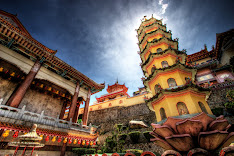Understanding Histogram
Posted by Kenny in Published Article on Sunday, March 6, 2005
One of the most important features of digital cameras which have changed the experience of taking pictures is the possibility of reviewing your picture at the point of taking a photograph. You are able to see if you have taken a good picture or a bad one and decide whether you should keep it.
However, most of us do not know about an additional feature in our camera that can also help in determining a good picture. This feature is called the histogram.
The histogram shows you the tonal range of your picture, usually depicted as the darkest to the lightest pixels in your picture. Reviewing your picture in such a small LCD on your camera, it can be hard to determine if your picture is of the right contrast level. A histogram can tell you details about your picture’s exposure and whether you need to make any adjustment to the settings on your camera.
A picture that is underexposed will show the following
You can see that most of the details are concentrated on the left side of the histogram showing that there more dark areas in your picture.
A picture that is overexposed will show the following
Here, most of the details are concentrated on the right side of the histogram showing that there are more bright areas in your picture.
In the above cases, what is necessary for you to do is to make the right adjustments such as using flash or to manually increase or decrease exposure level. Most of the time, your camera’s auto exposure feature will correctly make these adjustments unless you are faced with extreme cases.
What do you do if you have already taken the picture?
It’s always best to get a picture just right from the point of pressing the shutter button. But, there are times where you can’t get back the same moment and you end up with a picture that’s not well exposed.
What can you do?
Don’t despair. This is one of the main reasons why there are a number of photo-editing software available to fix the problem.
I’ll use Adobe Photoshop to give you an example of how you can fix your picture. Most good and even basic photo-editing software would have this feature available for you to make adjustments.
Using Levels
For most people the simplest way to adjust the tonal range of a picture is to just use brightness and contrast feature. However, this method leaves you with little control over the results of the adjustments.
Last month, I talked about using an adjustment layer. To recap on this, click on the on the black and white button at the bottom of the Layer box and select Levels.
You will then see a histogram which displays the level of colours for the red, green and blue (RGB) Channels.
If you see empty gaps on either side of the histogram, this means that your picture has low contrast level and could be better with a slight adjustment.
Move the slider on both ends to the edge of the histogram where there are tonal details. You can see the change in your picture instantaneously as the contrast level improves.
What you have done is actually improving the overall contrast of your picture by spreading the colour details over the entire tonal range. This makes for a more pleasing picture to look at.
The middle slider is used to adjust the overall brightness, or gamma level of the picture.
If your picture suffers from a colour cast, either due to poor lighting or a problem with white balancing, you can select the individual colour channel, red, green or blue and move the sliders to make adjustments to correct the colour.
Here are a couple more examples of how pictures can be improved by checking and tweaking the levels in a histogram.
Do remember that there may be some cases where it is not necessary to make the above adjustments such as pictures of a grey object, a misty atmosphere or soft colours of a fabric. It may be quite a subjective issue and you have to judge for yourself if it looks fine after the adjustments. Now that you know the basic steps in adjusting your picture levels, try practicing this on your existing pictures. In the next few months we will come across this feature to do some creative digital photo effects.

